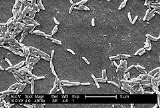
Campylobacter fetus
Encyclopedia
Campylobacter fetus is a species of Gram-negative
, motile bacteria
with a characteristic "S-shaped" rod morphology similar to members of the genus Vibrio
. Like other members of the Campylobacter
genus, C. fetus is oxidase
-positive.
in cattle and sheep, C. fetus is an opportunistic human pathogen
and can cause bacteremia
and thrombophlebitis
. Though rare, C. fetus can lead to fatal septicemia in newborns and immunocompromised individuals
. It is the only Campylobacter
species that can give septicemia. Bacteremia can lead to localized infections of the meninges
in the brain, the respiratory pleural spaces or lungs, joint
s
, the pericardial sac
around the heart, or the peritoneum
.
Gram-negative
Gram-negative bacteria are bacteria that do not retain crystal violet dye in the Gram staining protocol. In a Gram stain test, a counterstain is added after the crystal violet, coloring all Gram-negative bacteria with a red or pink color...
, motile bacteria
Bacteria
Bacteria are a large domain of prokaryotic microorganisms. Typically a few micrometres in length, bacteria have a wide range of shapes, ranging from spheres to rods and spirals...
with a characteristic "S-shaped" rod morphology similar to members of the genus Vibrio
Vibrio
Vibrio is a genus of Gram-negative bacteria possessing a curved rod shape, several species of which can cause foodborne infection, usually associated with eating undercooked seafood. Typically found in saltwater, Vibrio are facultative anaerobes that test positive for oxidase and do not form...
. Like other members of the Campylobacter
Campylobacter
Campylobacter is a genus of bacteria that are Gram-negative, spiral, and microaerophilic. Motile, with either unipolar or bipolar flagella, the organisms have a characteristic spiral/corkscrew appearance and are oxidase-positive. Campylobacter jejuni is now recognized as one of the main causes...
genus, C. fetus is oxidase
Oxidase
An oxidase is any enzyme that catalyzes an oxidation-reduction reaction involving molecular oxygen as the electron acceptor. In these reactions, oxygen is reduced to water or hydrogen peroxide ....
-positive.
Pathogenesis
In addition to causing some cases of abortionCampylobacteriosis - Cattle
Gastrointestinal campylobacteriosis is caused by Campylobacter jejuni or Campylobacter coli. Although it is a commensal in the gastrointestinal tract of many species, it can cause diarrhoea - mainly in young animals. It is most commonly seen in cattle but may also infect many other species...
in cattle and sheep, C. fetus is an opportunistic human pathogen
Pathogen
A pathogen gignomai "I give birth to") or infectious agent — colloquially, a germ — is a microbe or microorganism such as a virus, bacterium, prion, or fungus that causes disease in its animal or plant host...
and can cause bacteremia
Bacteremia
Bacteremia is the presence of bacteria in the blood. The blood is normally a sterile environment, so the detection of bacteria in the blood is always abnormal....
and thrombophlebitis
Thrombophlebitis
Thrombophlebitis is phlebitis related to a thrombus . When it occurs repeatedly in different locations, it is known as "Thrombophlebitis migrans" or "migrating thrombophlebitis".-Signs and symptoms:...
. Though rare, C. fetus can lead to fatal septicemia in newborns and immunocompromised individuals
. It is the only Campylobacter
Campylobacter
Campylobacter is a genus of bacteria that are Gram-negative, spiral, and microaerophilic. Motile, with either unipolar or bipolar flagella, the organisms have a characteristic spiral/corkscrew appearance and are oxidase-positive. Campylobacter jejuni is now recognized as one of the main causes...
species that can give septicemia. Bacteremia can lead to localized infections of the meninges
Meninges
The meninges is the system of membranes which envelopes the central nervous system. The meninges consist of three layers: the dura mater, the arachnoid mater, and the pia mater. The primary function of the meninges and of the cerebrospinal fluid is to protect the central nervous system.-Dura...
in the brain, the respiratory pleural spaces or lungs, joint
Joint
A joint is the location at which two or more bones make contact. They are constructed to allow movement and provide mechanical support, and are classified structurally and functionally.-Classification:...
s
, the pericardial sac
Pericardium
The pericardium is a double-walled sac that contains the heart and the roots of the great vessels.-Layers:...
around the heart, or the peritoneum
Peritoneum
The peritoneum is the serous membrane that forms the lining of the abdominal cavity or the coelom — it covers most of the intra-abdominal organs — in amniotes and some invertebrates...
.
See also
- CampylobacteriosisCampylobacteriosisCampylobacteriosis is an infection by the Campylobacter bacterium, most commonly C. jejuni. It is among the most common bacterial infections of humans, often a foodborne illness. It produces an inflammatory, sometimes bloody, diarrhea or dysentery syndrome, mostly including cramps, fever and...
- Campylobacteriosis - CattleCampylobacteriosis - CattleGastrointestinal campylobacteriosis is caused by Campylobacter jejuni or Campylobacter coli. Although it is a commensal in the gastrointestinal tract of many species, it can cause diarrhoea - mainly in young animals. It is most commonly seen in cattle but may also infect many other species...

